BIOB38 Final
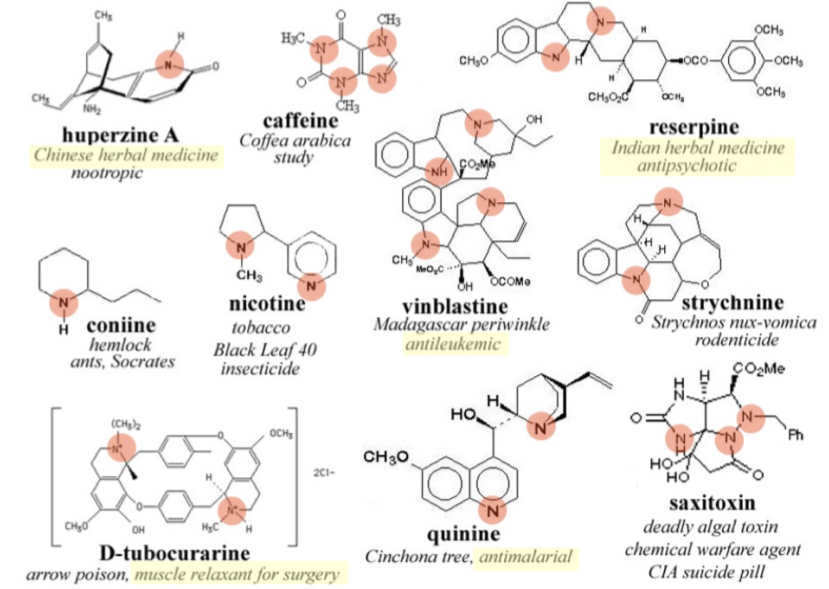
Table of Contents
Plants that feed the world
Plants that please the palate
Plants that heal the sick
Plants that hook the mind and body
Plants the world thirsts after
Plants of warmth and strenght
Plants that feed the world
Of the top plants feeding the world, cabbage is the only green vegetable, however cabbage is so broad and belongs to yellow mustards.
Cabbage
The Yellow Mustards
It is hard to find the differences between them, because when they flower they look exactly the same. They are all part of the Brassica family.
The relationship are very complex, with black mustard, wild cabbage, and common turnip as the four horseman of Brassica.
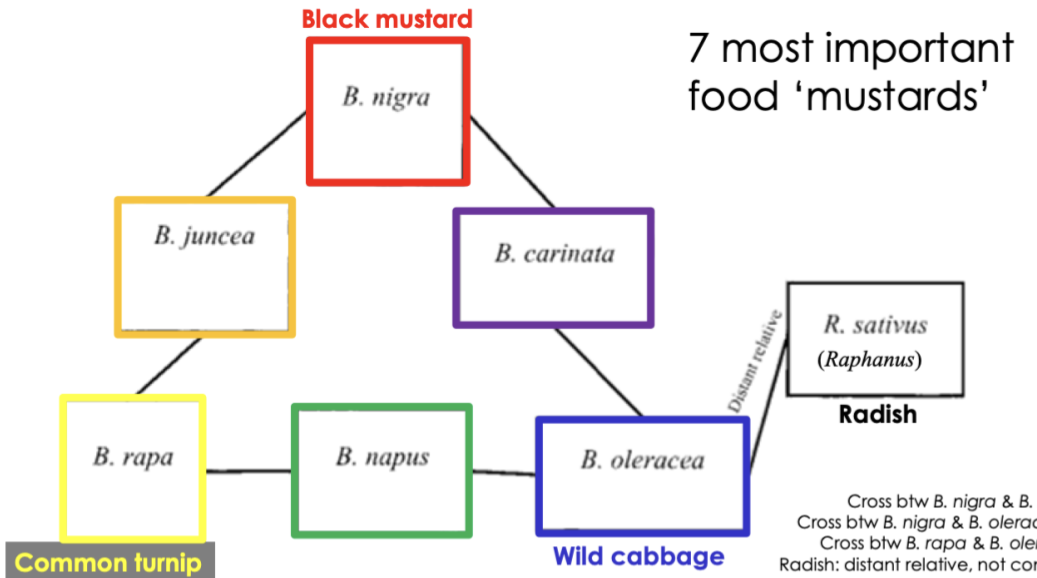
Independently are good species, and there are hybrid species (secondary colours). Radish is not a Brassica, but it is a relative.
Brassica oleracea (European wild cabbage)
It resides along the atlantic coast or mediterranean coast. Flowers in year 2. Year 1 is about investment into storage organs, while year 2 is about plants drawing reserves from storage organs to reproduce. Seeds germinate, grow into rosette, seeds store energy, pumps into inflorescences → lifecycle takes place over two years.
Brassica rapa (common turnip → asian cabbage)
Stem is a little inflated as it stores energy from year 1, grabbing energy from year 2 into inflorescence. Different types of mustards come from all of Brassica. Crossing rapa with nigra will produce chinese mustard
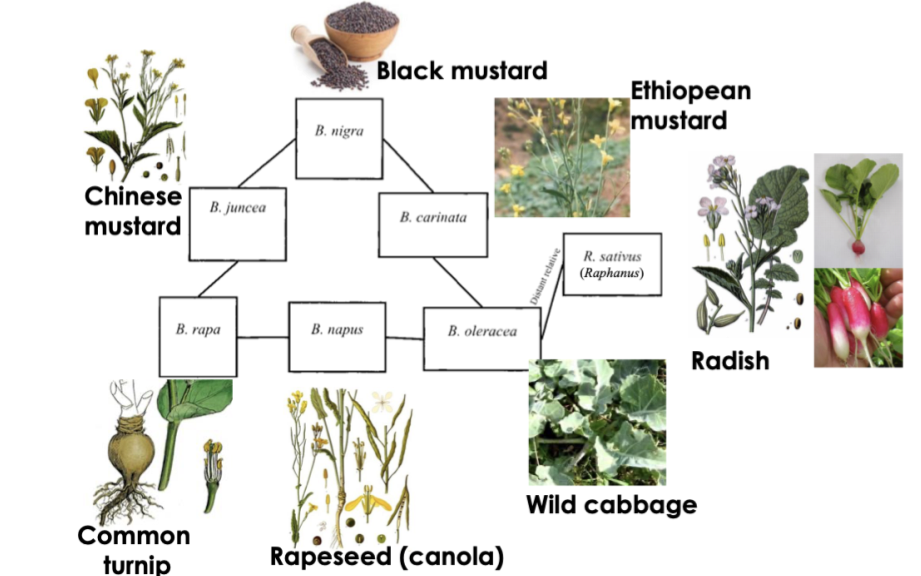
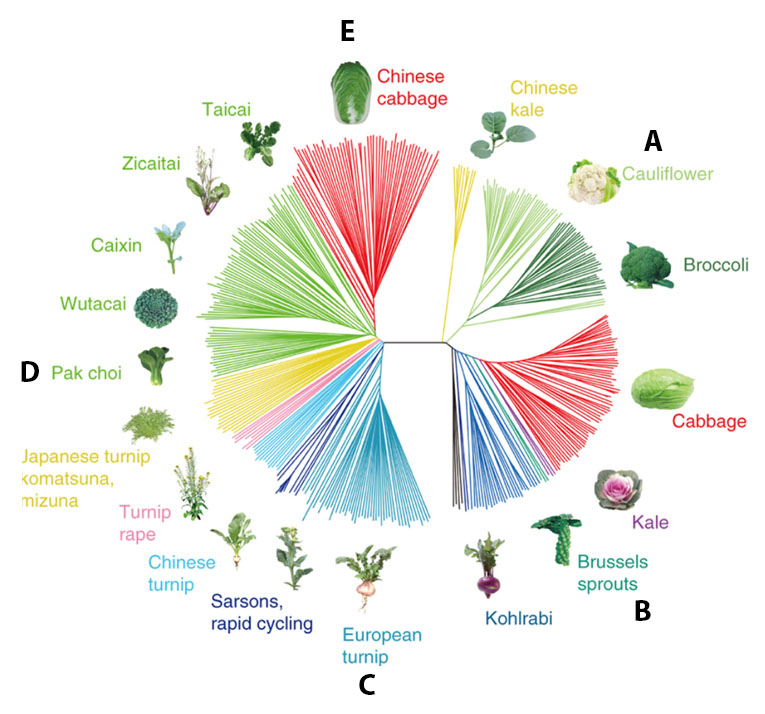
The Brassica triangle has varying geographic origin.
B. oleracea + B. rapa - China (2.54 mya)
B. nigra - Asia, Iran (18 mya)
Tribe - south of China (24 mya)
Species moved towards western side of North Africa and another moved across the Mediterranean into Greece and Turkey. Some land individuals are seeds, gave rise to turnips.
We can sort all the cabbages into vegetables. Two large groups of Brassica rapa (asia) vs. Brassica oleracea (Europe). European turnip and Chinese kale are outliers of which species they belong to
European Brassicas
Brassica oleracea. Wild ancestor to all EU cabbages. Grows wild along Mediterranean and Atlantic coasts. Sweet succulent and tastes good. Good sample for farmers to work with in their gardens. All are infertile.
Cabbage used as food - harvest storage organs, and you truncate stuff. Storage organs are of interest as human food. Best cancer-fighting Brassica.
Chinese kale
Cauliflower - 1500 AD in the Mediterranean. Selection for larger and more succulent flower buds (flower clusters), resembling a bunch of grapes. We eat the flower bud. Big inflorescence, if we wait a year, it will grown into an actual flower.
Broccoli - 1600 AD in Italy. Selection for larger and more succulent flower buds and stem. Doesn’t store energy in one place. Geometric pattern has same idea as classic broccoli.
Cabbage - 100 AD by roman empire. Selection for larger, more succulent apical (main) bud (terminal buds) → cabbage, and is known in contrast to kale to have a head.
Green cabbage was also bred to be red cabbage
Kale - Roman empire (500 BCE) selected for larger and more succulent leaves. It is known as a supergreen because it is super healthy. It is without a head
Brussel sprouts - 1800 BC , selected for tightly packed and more succulent leaf buds (lateral buds) → bearing gems. By the end of fall, there is already a stem, and flowers are inserted into mini cabbages (coverings of leaves).
Kohlrabi - 100 AD in (modern day) Germany. Selection for larger and more succulent stem basis (stem turnip). Domesticated in completely different area from others.
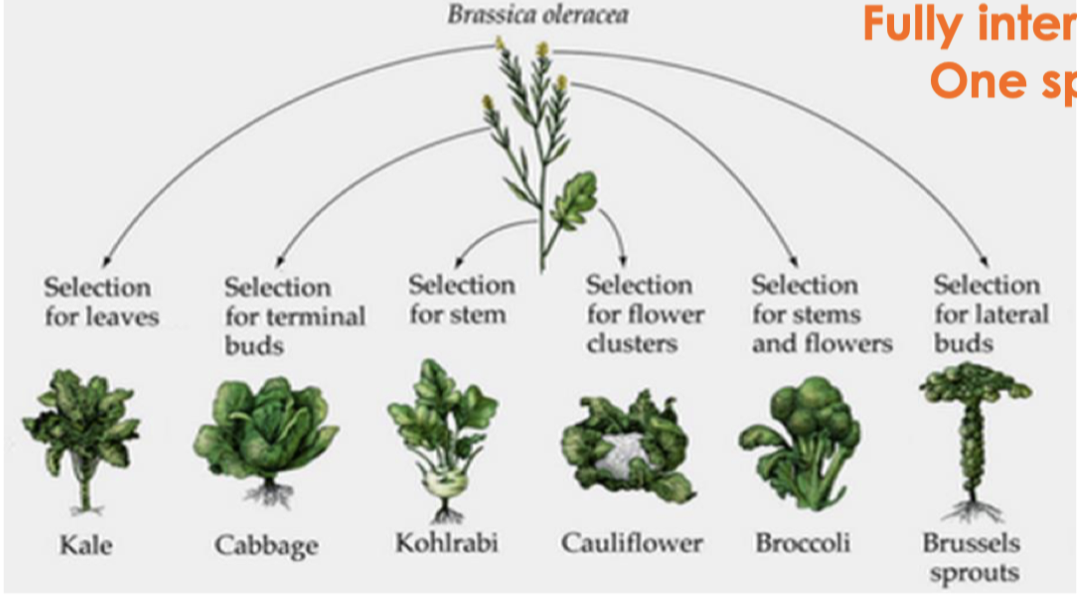
Asian Brassicas
Brassica rapa.
Chinese cabbage - 1600 Ming Dynasty. Softer leaves than cabbage. Plant produces leaves, photosynthesizes in year 1 and stores energy in leaves. Second year draws resources to create flowers to reproduce.
Kimchi: pickled/fermented chinese cabbage. Probiotic - gut-friendly, lactic acid bacteria with many health benefits.
Pak choy: chinesis. Various versions. Same and similar to cabbage.
Pak choi and chinese cabbage have thick and fleshy (succulent) leaves
Leafy greens
Taicai, zicaitai, caixin, wutacai, Japanese turnip, Sarsons (rapid cycling)
Used in stir fries.
Turnips
Brassica rapa ssp. rapa: purple turnips, huge bulbs.
Health benefits of cabbage
All of the above things are spoken about here
Antioxidants, isoflavonoids, Vit C, fibers, glucosinolates (what makes it bitter)
2ndry compounds: good for digestive system, decrease certain cancers, decrease stroke, decrease inflammation.
Supergreens: lots of good secondary compounds. Deterrents of herbivores are why kids don’t like vegetables.
Glucosinolate: Doesn’t want to poison itself, so it works in the vacuole in an inactive form. When we cut cabbages in half with teeth, we cause myrosinase to interact with this and stop us from dying. The cancer-fighting properties are associated with this.
Cancer and cabbage: have to rely on interviews, a few studies show positive correlation between cancer-free and cabbages, some looked more closely. Colon, stomach, lung, and rectum are most positively associated.
Integration of cabbage
Artificial selection on both brassicas produced different storage organs.
Change harvesting at prime-time storage. Begins harvesting right at the end of year one when it is at peak storage of energy.
Convergent artificial selection: independently farmers pushed for artificial selection of two species. Turnips have a large stem base. Different green leaves can be used for same things.
Both groups have very healthy secondary compounds
Legumes
Why mighty?
Legumes is small in terms of volume of tons of make-up, but they are incredibly important as the group that produces the most protein.
Fabaceae: produce seeds in pods; > 13,000 wild species. They have a symbiotic relationship with Rhizobium inhabiting root nodules. Rhizobia converts atmospheric nitrogen into plant usable nitrogen.
Nitrogen fixation: Seeds very rich in nitrogen are key in building proteins, and these symbiotic relationships make legume a good source of protein.
Rhizobia N → plant N → legumes rich in N → N: key building blockof protein → legumes: great source of protein
Domestication of legumes: Common bean in Central + S America, Soybean in China. 22 domesticate species worldwide. Different local varieties as well. Most important by continent. Says where it was domesticated.
Common bean (Phaeolus vulgaris)
Domesticated in the new world, recognized as incredibly useful and spread from the Americas.
Huge varieties. Versatile legume, pods and beans. Different basic morphologies - pole and bush types, snap beans and dry beans.
Pole beans: weak spine needs to wrap around, you gotta search for right pods.
Bush beans: Stay sedentary and low, greens grow all in same location for harvest. Bean cluster are easy for harvest.
Snap (fresh or green) beans (Phaseolus vulgaris), common bean: Farmers market shows wide range of diversity of beans. Pigmentation, most colours can be boiled away, the pods all probably taste pretty similar.
Dry beans, common bean (Phaseolus vulgaris): Even bigger diversity in the actual beans inside. All the same thing. Farmers wait till pods are right, and then do production. All taste and have same effect. (cranberry, black, flageolet, great northern, kidney, navy, pink, pinto, white, yellow).
Huge diversity: limited mobility among early farmers, where it ends up it’ll stay there and gain its own set of characteristics
New world: beans and peanut were domesticated in the new world.
Fertile crescent: chickpea, lentils and peas
China/Japan: Red bean and soybean
Soybean (Glycine max)
Fairly high on the top 20 plants in the world (7). It has high protein, making it a good feed.
Domestication: 7000-6600 BP in China
Introduced to Japan 5000-3000 BP
Introduced to Korea 1000 BP
Formation of edamame: seed pods harvested before seeds fully ripen, seed pod and seeds are still green and soft. pod is cooked.
Soybean products: regular, sprouts, milk, oil, tofu, yuba, soy sauce, tempeh, TVP
TVP (Textured vegetable protein): High quality waste product, used for oil extraction. Healthy protein once you remove the oil.
Fermented products: soy sauce, tempeh, TVP
Best meat replacement: highest protein of any plant food. 5-10x protein per area than if animals were fed by greens produced by the same area.
soy > hemp > lentil
We grow soybeans today in southern Ontario into Northeastern USA, as well as parts of east asia and Brazil/Argentina.
Tofu
2000 BP - China. Spread of Buddhism → spread of tofu. Staple in China, Vietnam, Thailand, Korea, and Japan
Can be made with any protein-rich legume
Steps:
Preparation of soymilk
Coagulation of the soy protein into curds
Pressing of curds to form tofu cakes
Coagulants: salts, acids, or enzymes.
Grind up the seeds to produce soymilk (a-helical proteins) → not functional proteins → heat up to denature into straight fibers → add curdling agent → lose string and starts coagulating → press to produce tofu
Yuba is the film on top of the boiled milk
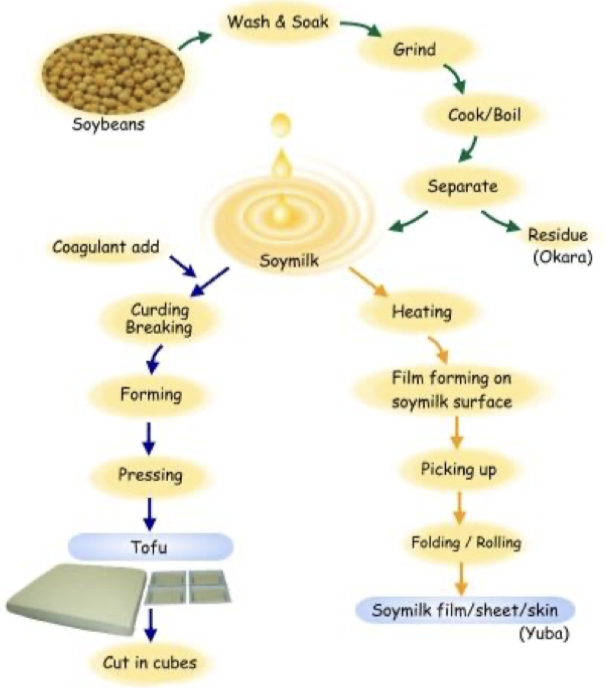
TVP
Side-product of oil extraction. Cheap, non-fat meat-analogue. If you extract oil from soy seeds you get highly valuable soy grounds = big chunks, mouth feel of chicken. pure soy protein (fat free), soaks up sauce due to pores.
Soy Sauce
Fermenting soybeans (+ wheat in brine with mold fungus, followed by yeast fermentation)
China 2200 y BP, Umami taste, spread of Buddhism to Japan and Korea.
Grind up soy seeds into thick paste → wait for white mold species to colonize (will digest) → yeast spores colonize as well → wait and then separate fibers from liquids and the liquid is the soy sauce → try stabilizing reactivity on developing soy sauce (pasturization).
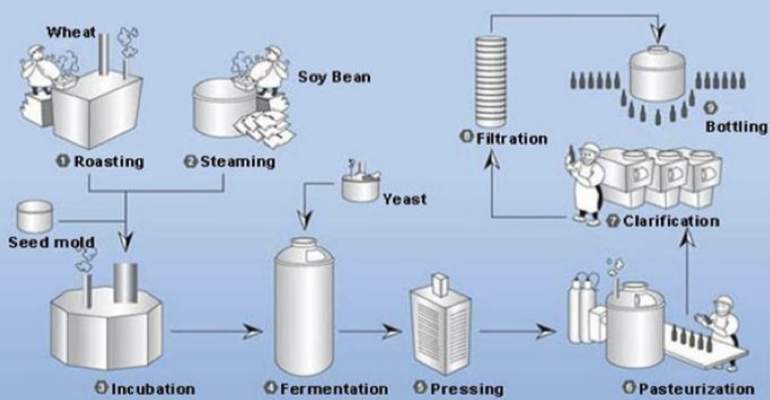
Miso
Fermented products. Seasoning paste, contains mix of soybeans, barley, rice, buckwheat, millet, rye and wheat. Fermented by mold.
Add a whole bunch of other seeds. Selected seeds. Mold likes to feed on soy, incubate and wait a year. Depending on seeds put in, the colour and taste differs.
Soybean → steam → add koji starter → mix in salt and water → cure → soybean miso
Tempeh
Fermentation by mold fungus Rhizopus binds soybeans into a cake form, similar to a very firm vegetarian burger patty. Shelled seeds, inoculate with rhizopus (pesky white fungus of strawberries). Mouth feel like a burger. Popular in Java.
Indonesia. Made by a natural culturing and controlled fungal fermentation process that binds whole soybeans into a cake form. This food is the only major traditional soy food that did not originate from Greater Chinese cuisine. Its retention of the whole bean gives this food a higher content of protein, dietary fiber, and vitamins.
Soy and Health Benefits
Increase good bacteria (lactobacteria, bifidobacteria), decrease bad bacteria (enterobacteria), increase gut health, decreased depression, increase immune function, decreased inflammation. Eating soy increases good bacteria in the gut, the better off you are.
Fermented products make nutrients easier for digestion to access, increase of good microorganisms, increase of gastro-intestinal health, anti-inflammatory.
Decrease in cardiovascular disease - Decrease LDL cholesterol (“bad” cholesterol). Increase blood circulation, mitigation of obesity and diabetes.
Soy - phytoestrogens. Soy isoflavones are similar to estrogen. Increase pregnancy chance, good for menopausal women, no negative side-effects.
Breast, prostate and colon cancer risk are all lowered.
Integration of all the different types of beans
Legumes extended soil fertility. Cover plant and add to rhizobium. Better under water stress by stretching limited water to a maximum.
Plants that feed Ontario
Three sister agriculture: Polyculture of corn, common bean, and squash = interplanting. Mexico 6000 BP, Ontario 1200 BP. Universal among native agricultural peoples of the Americas.
Corn: pole, hungry for nitrogen
Bean: increase soil N levels (symbiosis with rhizobium) needs a pole
Squash: decreases weeds through big leaves, mulch
Polyculture: increase pest resistance
First nation villages in Southern Ontario
1200 people per village. Family clan in long house (100 people). Polyculture surrounded their walls.
Select larger and more fertile corn - pre-soak seeds in long house to extend growing season.
Women pre-germinated seeds in the houses so they would grow quicker. Selection. Started tiny and got bigger.
Spring planting: poke holes into soil with stick, create mounds. Corn seedlings planted in mound, typically same hill used every year. Plant beans and squash planted two weeks after corn. If close to water it will fertilize with dead fish.
Summer: after sowing seeds, women and children tend to fields, chase away raccoons, don’t desemate the field.
Corn: Staple, number 1 plant in calories. Indigenous cuisine centers corn. If it failed this would result in starvation. Corn has most calories per unit area. How often you find corn or bean vs. squash. Easily storable.
Beans: less productive than corn per calories, but important for protein.
Squash: fresh flesh only available during few months, seeds storable and nutrient dense and health (fat and protein).
food breakdown (% of calories in diet): Corn 65%, beans 13%, squash 2%, fish 9%, terrestrial animal 6%, gathered food 5%
First nations were remarkably health. No evidence of rickets, scurvy, cavities, general malnourishment.
Plants that Please the Palate
Use of herbs and spices have been used since antiquity. Sage (magic rites and spells. Purification. Embalming. Perfumes, cooking, poison, aphrodisiacs, healing.
Spices: earliest evidence from >10 000 BP in India. Archaeological evidence.
Pepper and pepper (piper and capiscum) make up more than half of world trade in spices/herbs.
Origin and numbers
Lamiaceae family: mint
Apiaceae family: parsely
All the spices from same geographic region (India). Very early on, very common in Indian food.
Mint family characteristics: Two leaves at same level, interchanging position (opposite leaves). Stem are rectangular with corner enforcements of collenchyma cells, allowing mint to be tall, and construction to be normal. Be pollinated, pellets fused to where nectar is inputed.
Parsley family characteristics: Flowers which are pretty tiny, organized in inflorescence. Often white flowers. Insects land to collect nectar and polleb. Always composite. Flat + curley.
Dill, fennel, parsley and cilantro are of Mediterranean or Near-eastern origin, part of the parsley family (Apiaceae) → best cooked at end for antimicrobial activity.
Common spices from Old World Tropics (Mostly India)
Pepper, cardamom, turmeric, ginger, cinnamon, cloves, nutmeg & mace.
Nutmeg and mace are the exception and grew wild in Indonesia.
Cinnamon we use the bark (only one)
New world tropics spices
Allspice (Mexico, Caribbean), All peppers (capsicum) (Central/South America), Vanilla (Mexico).
Only food producing orchid: Vanilla → Climbing vines, freshly harvested seed pods are then dried and cured. We use the tiny black seeds inside. Very expensive spice. 3rd most expensive.
World trade in important herbs in spices: Pepper (piper), capsicum peppers. 54 000 tons, 42 000 tons. Spices today are the big business.
India produces 86% of the world’s spices. 1 600 00 tons.
Vanilla is the only orchid herbs or spice.
Plants and their defense against their enemies
Obviously plant don’t want to be eaten. Chemically they have toxins, where herbs and spices come in. Plants use precious energy, and secondary compounds to produce toxins. Spices are a chemical defense.
Secondary compounds
Phenolics: discourages germs/herbivores, low toxicity
Intense smells and flavours. 2 groups: flavonoids and anthocyanins.
aromatic ring in molecular structure
Terpenoids: discourage germs/herbivores; low toxicity
intense smells (volatiles) and colours
Built from C-5 building blocks
Built from isoprenes
Glycosides: discourage germs/herbivores; very toxic
Always a sugar part connected to the active portion of the total molecule
Alkaloids: discourage germs/herbivores; bitter, very toxic
Presence of nitrogen in its molecules.
Phenolics
Antioxidants, capture free radicals. Cancer-fighting, anti-inflammatory, collagen-building.
2 classes - don’t need to know difference on a molecular basis. Many flavonoids have intense colours. Purples are the anthocyanins, while the red and yellow are flavonoids.
Onion, ginger, mint, strawberries, blueberries/grapes
Terpenoids (essential oils)
Five-carbon isoprene units. Multitude of different function groups and basis C-skeleton. Used extensively in aromatic qualities, important in traditional herbal medicine. Vanilla, ginger, citrus.
Huge group. Doesn’t just produce groups, but dozens and dozens more. Very intense flavours.
Volatiles. Terpenoids add a lot of flavours to our food. Enter through nose or mouth, you taste it. Mints are very commonly in having it.
Glycosides
Chemically diverse. Sugar compound (glyco-) attached to the active compound. Nomenclature based on nature of active compound. Sugar component attached to the active compound.
Alkaloids
Very diverse group of compounds. Common chemical properties of nitrogen, alkaline, bitter taste. Ends in -ine. Disrupt liver and cell membrane function, as well as the nervous system.
4000 known alkaloids from over 300 families and over 7500 species. 20% of temperate plants contain alkaloids.
A lot of plant drugs are alkaloids.
Safe storage of toxins in plant tissues
Stored out of harms way in the vacuole. Anthocyanins, alkaloids, glycosides, phenolics.
Stored as inactive precursor, activated by chewing. This is all so plants don’t poison themselves.
Why do we eat spices?
We aren’t the typical target enemy of spices and herbs. Larger amounts would be needed to kill us. Size matters.
Paracelsus: all things are poisonous, it’s the dose that matters.
Babies prefer bland foods, don’t have metabolic processes to deal with spices yet. Don’t expose toxins in spices to the fetus.
You need to be a botanist to ensure people don’t die. Poison hemlock looks like parsley plants (caraway, coriander, anise) and it was the deadly potion which killed Socrates (it is part of the parsley family).
Evolutionary reason gotta be there.
Indian food: one of the least bland cuisines in the world, and the hottest climate
Norway: one of the most bland cuisines, cold.
Meat putrefaction: especially dangerous to eat meats in hot places. Spices can cool down microbial adaptation. They’re there, just grow slower.
Predictions:
Spices should kill or inhibit food-spoilage
Spices should be used most in hot climates
Spices should be most favoured in areas with hot climate
Experiment: looked at all the meat recipes across all the countries and traditional cookbooks.
93% of all recipes use at least one spice, average of 3.9 spices per recipe. Onion most common, pepper (piper) also really common.
Wide range of spices in India, with only a few spices in Norway. Most pepper, parsley, and onion.
Worldwide top three: Garlic, onion and pepper (piper)
Lab results should that spices slowdown bacterial growth, not kill or antibiotic. Garlic, onion, allspice and oregano were the 4 that slowed 100% of bacteria.
Commercial food preserving uses 0.5-1.0 g/kg of meat. Most sufficiently to yield useful antibacterial effect.
Potency decreases with cooking time. Spices added early, herbs added at the end.
Lemon and pepper: synergism. Not good solo, but together the low pH of lemon/lime juice brings something out of the pepper.
Pre-mixed spice mix. Slow down food putrefaction. Clear support for the hypothesis. Garam masala contains the many spices or herbs.
Resistance to single/multiple spices.
Most potent spices are active in hotter areas - garlic, cinnamon, cumin, capsicums, onion. Dill and parsley aren’t as correlated with hot v cold places (lame duck spices).
29.2/100 000 japanese people got food poisoning, and only 3/100 000 koreans did. While koreans use drastically more spices. More highly potent spices as well.
Spices are not nutritious. Covering up rotten smells doesn’t make sense.
Spices are used cuz they’re tasty and cover the blandness of foods: many are pungent and many are painful. They are initially unappealing so we would likely not be involved this way.
We put in a lot of effort, time and money for spices, and it’s just not worth.
History of herbs and spices
Colonialist view: war on spices.
India and Asian spices are very important and the spices travel throughout the world. The silk road collects. India had first evidence of spices used 10 000 years ago.
The silk road: 2 year travel time, overland transport. Earliest spices used were cardamom, cinnamon, cloves, cumin, ginger and pepper. First evidence in the middle east was 2000 BCE. India, China, Iran, Turkey, Mongolia, etc.
Cloves: Native to a few Molucca islands (Spice Islands in Indonesia). Found in pottery in 1721 BCE. Very long travels.
Trade winds: promoted the spice trade. Discovered by Greek navigators 40 CE. Prevailing winds blow SW April - September and NE October - March. Predictable sailing conditions. They bring Monsoon. Brought things to Europe. No correlation with the Silk Road.
Greeks and Romans: Pepper, anise, caraway, cumin, mint, mustard, ginger, basil, laurel, marjoram. Pepper and Ginger imported from India. Used medicinally and documented by Dioscorides.
Pliny the Elder (23-79 CE): He wrote and questioned why they used so many spices from India
Romans liked it hot.
Middle Ages and Age of Exploration
Few spices make it into Europe (most via Venice), sea ways and overland routes largely controlled by Arabs. All the culture brought into the mediterranean were taxes by the Arabs.
Marco Polo: travel log. Upon his return, he was arrested and wrote a book. Spices and riches he wrote about, inspiring age of exploration.
Pound of ginger for a sheep. Pound of mace for herd of sheep or a cow
Pepper could be used to pay taxes
Adulteration of saffron resulted in being burned to death.
Beauty of the medieval period was heavily reliant on temperate herbs, what could be grown in a garden.
Caravel ship used = sails into the wind easily, light, maneuverable. Rise of Portugal as a great sea power. Greedy for spice and gold.
Voyages of Diaz and Da Gama: Portugal → Cape Verde → South Africa (cape of good hope) → Mozambique → India
Spain sent columbus to find new route to Asia
Britain vs. Spain: start of the end of the Spanish and Portuguese sea influence. Portugal was side-stepped. Britain won out. Continued on quest to dominate the world.
England and Dutch dominated the late age of exploration. Two influential eastern spice trading companies. Netherlands exploiting Indonesia while GB exploited South Asia.
Dutch East India Company, English East India Company. 1600s - 1900s
In the 16th century, the Middle Ages gave way to The Age of Exploration . This was triggered by the invention of the Caravel by the Portuguese who wanted to bypass the Italians . This vessel was relatively light and maneuverable and the novel construction of its sails made it possible to sail into the wind . This made open ocean sailing possible. The Portuguese crown funded the exploration of a novel sea route to India along the Cape of Good Hope . The full trip to India with the circumnavigation of Africa was eventually achieved by Vasco da Gama
Colonialism
Specifically looking at mace and nutmeg from the Molucca islands
Narrow range of nutmeg and mace. European competition for the riches of the world. Spice producing areas were fought for how to get there.
Access to cloves, mace and nutmeg was dominated by Portugal and Spain for awhile, and then Amsterdam. Amsterdam is nice because it squeezed colonial goods out of colonies. French stole trees and put them into Zanzibar, and Molucca is no longer the go to place.
You must sort out harvest cloves as an immature flower bud, get them to open. You then dry them by laying them out. Dry and ship when they’re brown.
Spices, indigo, cotton, tea, opium, wheat and rice all imported from Asia.
Repeat mass famines in India due to colonial exploitation. There was a chinese opium addiction.
Species of poppy (morphine and opium) - used by British from China. A quarter of the population was a addicted and Britain needed them to stay addicted.
Transatlantic trade triangle
Caribbean → Africa: slaves
North America → Europe: rice, silk, indigo, tobacco, sugar, wood, etc.
Cotton was a huge part. Canada was still a British colony, USA had colonies in the tropics. English dominance in South America. Rest was independent.
New world commodities: sugar, tobacco, indigo, molasses, cotton.
Africa gave out plants and other commodities to France and England mostly. Lots of Ebony wood. Wood number 1 export. Centre of the stem was black. complete black tint which gave lasting furniture of black wood no need to dye it.
Plants are very important and they drove how the world was carve up by just a small area. Colonialism is still felt today through poverty and inequality. Shows areas of war and peace. Peace is very low, crosses to where Europeans exerted their power. More war in areas with high colonialism. Average income of the US comparison of white and black families show a much lower range.
Plants rule the world and were an important driver behind colonialism, hence co-shaped global history.
Plants that heal the sick
Secondary compounds
Phenolics (tannins), terpenoids, glycosides, alkaloids. Benzol ring.
Tannins: mitigation of chronic diseases, infection, degenerative disease, inflammation, cancer.
Terpenoids: essential oils. Glycosides: medicinal ones, there is a cardioactive group. It helps with heart function (foxglove). Slow down of heart beat (heart flutter), increases power of the heart muscle. Too much could kill you.
Medicinal alkaloids: chinese medicine, indian herbal medicine (antipsychotic), antileukemic, muscle relaxant, antimalarial. Colchicine, piperine, tubocurarine, or vincamine.
Short history of herbal medicine
How we have seen humans use plants for healing purposes.
Ancient civilization
Charaka-Samhita: It is a comprehensive text on ancient Indian medicine based on the traditional system of Indian medicine known as Ayurveda. It was written sometime between the 2nd century BC and the 2nd century AD.
Animals tend to not only eat plants for energy, but for anti-worm divvy in chimpanzees. Some plants have no nutritional effect and they still eat them for health benefits.
2000 y BCE in Sumerians - physicians were respected and specialized. Cuneiform tablets had detailed descriptions of the preparation of numerous remedies. First evidence of humans discussing healing powers.
4000-2000 y BP - many important medical papyrus rolls include therapeutic recipes. Poppy was used as a pain killed for a long long time now, similar to today. China - Shen Nung (4500 y BP): mythical emperor and father of Chinese medicine. Investigated medicinal value of 365 herbs. Oral history on the use of herbs: pharmacological categories, toxicity, dosage.
Shen Nung Pen Ts’ao Ching = book of his ideals written 2000 y after his life
Western medicine caught up to him in the 20th century
Ephedrine and pseudoephedrine was given for asthma = expand bronchial tubes, constriction of blood vessels, stimulation of the brain, increase of heart rate. Energy drinks have these.
Ginkgo for lung and heart disease = fights cardiovascular disease, improve blood flow to brain, improve cognitive function, memory and depression.
Ancient Greece - foundation of western medicine
Hippocrates: used a lot of herbal remedies, medical confidentiality
Theophrastus: Enquiry into plants and causes of plants in western renaissance movement
Dioscorides: summary of all plants known at the time, book was used until 1500s
De Materia Medica (by Dioscorides): manuscript copied by hand in Greek, Latin, and Arabic throughout the mediaeval period. 2nd-16th century with 600 plants, 90 minerals and 30 animal products. Used to ID plants.
Listed Silphium as a contraceptive: plant only occured in the wild (resistant to cultivation) in a narrow strip along the Mediterranean. Seeds were heart shaped. Managed by occupying Greeks sustainability. Roman occupation caused it to go extinct due to overharvest. First documented extinction in the world.
Middle ages to Industrialization
Arabs introduced knowledge to Europe about healing. Also moved into Northern Africa. Job description of a farmer introduced at this time. First apothecary shop (Baghdad).
First beginnings of chemistry: new plant drugs beyond Greek and Roman ones. 9th century had 637 medicinal plants, to the 13th century 1300 medicinal plants. Written in greek used by Arab scholars. Pharmacology became an independent branch of medicine - if you’re coughing, use this. Introduction of experimental scientific method → separate hear-say from hard evidence.
Avicenna (Ibn Sina): Polymath. Most significant physicians, astronomers, philosophers, and writers of the Islamic Golden Age. 450 works written, 240 have survived, 150 on philosophy and 40 on medicine.
Cannon of medicine: standard medical text at many medieval universities beyond the islamic world until 1650.
Ideas on the nature of infectious disease, first implementation of quarantine. He did not know what spread and what transferred to humans, but he knew quarantine would stop it.
Ibn Sina - study of internal anatomy. Cut up dead human bodies to see how the work. Was not allowed in Europe at the time.
Wellness: maintenance of health, emphasis on hygiene and pure life. Introduced quarantine and hygiene.
The most prominent representative of the Islamic Golden Age was Ibn Sina , also known by his Latinized name Avicenna in the West. His most famous works are The Book of Healing, a philosophical and scientific encyclopedia, and the Canon of Medicine , a medical encyclopedia which became a standard medical text at many medieval universities and remained in use as late as 1650. This collection of books still forms the basis for clinical trials and pharmacology.
Little new knowledge was added in Europe. Old knowledge was preserved in monasteries, hand-transcribing old books. De Materia Medica was copied and re-copied. Monks gather or grew herbs. Monasteries were learning and making books.
Age of Herbals (Renaissance in Europe): renewal of learning (15th century), revival of herbalism, printing press (invented 1440 by Gutenberg) triggered this age. Mass producing books and knowledge spread easier. Paper became the limiting factor.
First European medical schools studied medicine and botany. Split between herbalism and scientific botany. Several universities throughout Europe did this.
William Withering: first to investigate a folk remedy, foxglove and its connection to heart failure. Set the standard for pharmaceutical chemistry.
19th century: purification of active compounds from medicinal plants. Breakthrough in pharmaceutical chemistry - isolation of morphine from opium (1806). Development of first synthetic drugs based on natural products (1850s). Morphine used to make a range of products in the lab.
There was a split between Western and Herbal medicine.
Western: only isolated chemicals used in prescription drugs → molecules designed for a specific target in human body
Herbal: uses entire plant: complex mix of chemicals → action of whole plants sometimes more than sum of its chemical parts = synergy.
Modern time
Decrease of direct use of plant extracts. Less based off the plants themselves, but rather what we’ve learned to synthesize in the lab. 25% based on plants, 50% based on fungal products. Reduce certain plant from scratch.
75-90% of people in developing nations rely on herbal medicine. Medicinal herbs sold in village markets. Practitioners of herbal medicine undergo extensive training. Rigorous training.
China: Traditional herbal medicine incorporated into modern health care system. Blend of herbal medicine, acupuncture, western medicine and 1000s of medicinal herbs used by Chinese herbalists. Holistic way to medicine.
Ethnobotany
Study of how human populations who have never been in contact with western lifestyle are using medicine. As a field, was invented in the 19th century.
Richard Evan Schultes is the leading figure in developing the field of ethnobotany
Study of local culture’s plants and their uses - medicine, food and clothing. Use interviews, and stay longer.
Mix of botany and anthropology. Need in-depth understanding of society in order to understand all aspects of life.
Must speak the language and respect rituals and levels of hierarchy.
Gender, healing and religion, herbal processing, cultural prejudice. All potential biases.
Modernization of ethnobotany: studied biology and upon graduating went to South America and lived among local tibed. Medicinal and hallucinogenic plants had a lot of personalities. Lots of fieldwork and life spent.
Modern ethnobiologists need botanical training, anthropological training, and linguistic training.
Ethiopian study example
Demographic, typical health problems, habitats of plants collected, growth characterisitics.
Majority of the plants are herbs, many shrubs and trees, few vines. How are the plants actually used?
Level of education, less education the more they know about local plants. Passed on from parent to offspring and old healer to new healer.
Knowledge of plant use and Plant ID herbarium are published for money. Monetization of local knowledge
Nagoya protocol (2010) - access to genetic resources and fair sharing of benefits arising from their utilization. Going about it in a decolonized way. States that houses a local population could be studied for non-monetary returns.
Peru fought against the monetary gains of local knowledge.
Case study in herbal medicine: old and new
Most botanical supplements: no biological activity, do not interact with prescription drugs, are natural and safe, are like prescription meds and have potential for interactions and side effects.
Not all that is natural is harmless - castor bean, angel’s trumpet, yew, poison hemlock
Herbal medicine: 7000 plants have medicinal applications. Drugs make a ton of money every year. Botanical supplements also sell a lot every year.
Garlic focus.
Garlic
A portrait
Infertile flowers - no sexual reproduction, no seeds. Produced via recombination (fits the general loss of sex in domesticated plants). Flowers can reproduce asexually with asexual bulbils = clonal copy of parent. Sterile.
Bulbils: development of garlic inflorescence. Starts to develop, they don’t go anywhere, becomes cloves.
Propagation: split bulbs into cloves and plant bulbs. Clonal propagation.
The sexual ancestor of garlic - Allium longicuspis most likely spread along the silk road east and west.
A - Flowers, B - Bulbil, C - Bulb, D - Roots, E - Shoot.
Use in ancient civilizations
Sumer: Mesopotamia saw garlic mentioned in clay tablets. Translated as “Annunaki produced 200 kg of garlic” how we tested what was owed to other people.
Egypt: fed to the working class, believed to maintain and increase strength and garlic remains are found in the tomb of Tutankhamun. Medical texts likes 22 medical formulas that contain garlic. Abnormal growth, circulatory ailments, infestations.
Greece: Used for strength in sport, similar to doping. Treats lung issues, internal and external cleansing, abnormal abdominal growths (found in palace of Knossos in Crete).
Garlic is not used in religious settings at it is seen as a staple of the lower class and due to its odor it is not allowed in temples.
Rome: Strength and endurance for sailors and soldiers. Trate arteries, gastro-intestinal issues, animal bites, joint disease and seizures.
The Divine Husbandman's Classic of Materia Medica recommends that garlic should be eaten daily , especially in in meat dishes for food preservation . Interestingly, the ancient text suggests that garlic be mixed with other herbs
China: Documented since 2000 BCE as a food preservative, part of daily diet, mixed with meat. Use of garlic documented by Shen. Treat respiratory and digestive issues (worm infestation, diarrhea), increase energy and male potency.
India: since beginning of script. Heart disease and arthritis. Bower wrote about infections, worms, weakness, fatigue, and digestive issues. Brahmin wrote it was not allowed in temples.
Europe: grown in monasteries for health purposes, and the upper class frowned upon garlic.
Summary of parallel health claims
Often food for laborers, increase of stamina and power, pulmonary/respiratory issues, cardiovascular issues, and in many cultures it was frowned upon by the upper class.
Modern use: scientific testing of health claims
Alliin: inactive form of allicin which is activated by crushing or ageing garlic. Has no affinity, and needs alliinase to get medicinal properties. Highly reactive. Whole range of compounds it can become.
Evidence of a decrease in stroke. Antimicrobial. Cholesterol, blood clot, blood sugar. Anti-carcinogenic.
HDL: (‘good’ cholesterol): high-density lipoprotein, protects against heart attack. Garlic only slightly decreases.
LDL: (‘bad’ cholesterol) low-density lipoprotein. Buildup of plaque in arteries. Garlic decreases.
Especially good for diabetes patients. Studies all on non-human models. Looking at effects, garlic was associated with hypoglycaemic effect.
Effect ameliorates symptoms and severity depends on crushed, aged and dose.
Negative effects: bad breath, blood-thinning (internal bleeding). Bad when taking blood thinners.
In studies which do not distinguish between HDL and LDL, the consumption of garlic decreases overall cholesterol , but only after an exposure of 4 months.
Patients who were given aged garlic (independent of how long the garlic was aged) had a significantly lower platelet adherence. Patients who were given aged garlic (independent of how long the garlic was aged) had a lower risk of blood clotting as patients who where given the placebo or nothing at all.
Garlic has a negative relationship with Gastric cancer. As does Scallions and chinese chives.
Decrease cancer, atherosclerosis, blood sugar, cholesterol, blood clots, is antibacterial.
Plants that hook the body and mind
Long human history of plant drug use
Magic mushroom dancers: Northern African rock painting showed a mushroom head and mushrooms in hand (9000-7000 y BP), evident of psychoactive drugs.
Peyote cactus: historic charicature in Mexico 8000 y BP. Cave painting.
Psilocybe (magic mushroom fertile crescent): 4500 y BP. Depictions of mushrooms with heads on them - two heads.
Fly agaric: Eurasia and Americas. Toxic and psychoactive. Connected to the head. Many drawings showed different effects. Mushroom growing out of head, eyes becoming mushrooms/falling out of eyes.
Opium poppy: opium goddess, Greece, 4500 y BP. Scratched/cut and oozing out. Pods growing out of head.
Phalaris DMT: cult of Dionysios, Greece 3500 years BP. Eurasian origin. Various gods have depictions of this grass. Attributed to the mind and mind altering effects of the grass.
Ayahuasca: amazon, Americas. Peruvian andes, 3000 y BP. Mortar and pesstal use. Snuffing tablets
LSD trip: artist drew himself throughout an LSD trip. 1950s when drug use was more liberal. Trip over 8 hours long. Very potent, messing with perception.
Ritualistic use of hallucinogens: Reasons why population use plants, a lot can be treated under psychoactive drugs. Part of education is about knowing how to use them.
Access to: spiritual world, ancestral advice, religious/philosophical insights, enlightenment, unconscious
Heal psychologically ill people, master shaman, aphrodisiac.
Not for recreational use. Small group-setting, increased group cohesion, reaffirmation of traditional values. Use was sanctioned and taught down, typically supervised by some type of elder at the benefit of society. Important people (ill, rites of passage).
Native Americans use the most species and Americas have a lot of specifically hallucinogenic drugs, sedatives, analgesic, aphrodisiac, and stimulant.
Mode of action of psychoactive drugs
Evolutionary perspective
We do something and it makes us happy so we do it. Drugs work in an award system where we separate wanting into needing.
Wanting is in mesolimbic tracts and liking is in brainstem. Liking means taking it and wanting more, then realizing it’s bad. Wanting keeps sending out message that it might be better this time.
Biochemical perspective
Majority of psychoactive drugs are alkaloids (not cannabis). Psychoactive drugs mimic neurotransmitters. Dopamine, Epinephrine, Norepinephrine, serotonin, glutamate, acetylcholine, GABA, endorphins. Stored in presynaptic vesicle, release into synaptic cleft.
Steps in neurotransmission:
Termination:
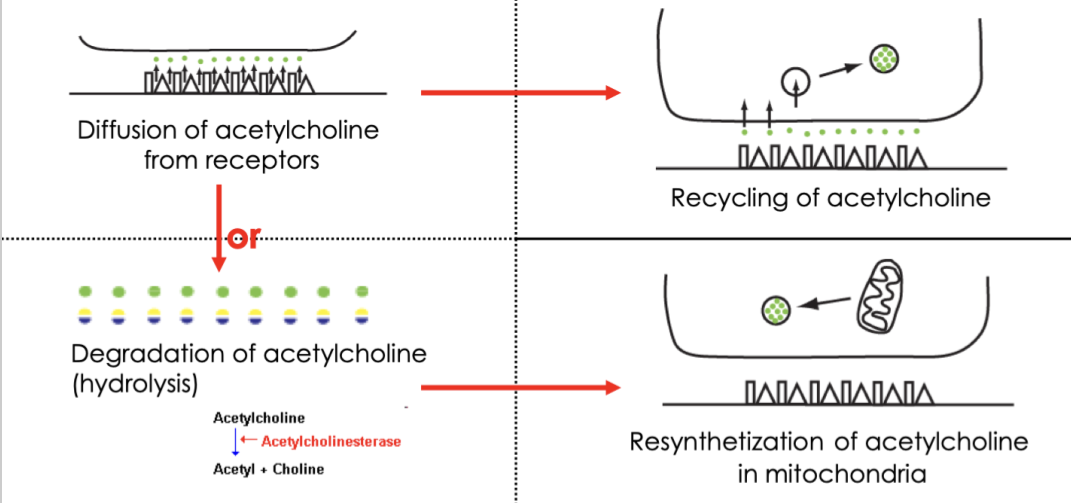
How does neurotransmission end? Some neurotransmitters are re-uptaken by the presynaptic axon and recycled . For that, they undergo endocytosis by the presynaptic axon and are packed into a vesicle. Other neurotransmitters are degraded after the release from post-synaptic receptors. To be ready for the next wave of neurotransmission using this particular type of neurotransmitters, they need to be produced anew by mitochondria .
Three basic types of psychoactive drugs
Stimulants: agonist. Excitation of CNS, increased mental alertness, decreased drowsiness, fatigue, hunger.
Theobromine, caffeine, nicotine, cocaine
Mimics neurotransmitter and simulant receptor. Buildup downstream action potential without any release.
Increased postsynaptic firing due to decreased rate of diffusion. After signal has been transferred, it stays longer.
Increased release rate of neurotransmitter, increasing postsynaptic firing.
Depressant drug: Prevents neurotransmitter from interacting with receptor, decreased awareness, decreased physical performance, sleep/trance-like state
Morphine, heroin, opium
Receptor site blocked by an inhibitor or antagonist → normal neurotransmitter cannot interact → decreased electrical impulse
increased diffusion of neurotransmitter from receptor
Decreased synthesis and storage of transmitter
Hallucinogenic drugs: Many classical of these interact with CNS with serotonin receptors as agonists → magic mushrooms (psilocybin), ergot fungus (LSD), ayahuasca (DMT)
Cannabis: often grouped into hallucinogens, but not a classic one. Has an antagonist and mild effect (very complex biochemistry).
Psilocybin: found in 200 mushrooms, euphoria, visual and mental hallucinations, changes in perception, distorted sense of time, spiritual experiences. Side effects: nausea and panic attacks.
Ergot fungus: infructence of grasses, spores land on flowers and overtakes. Grain impurities - ergotism, seizures/psychosis, gangrene of finds and toes through vasoconstriction (chronic poisoning). Medical use to stop postpartum bleeding. Psychoactive LSD. Side effects: nausea and seizures Issues in wheat production.
Ayahuasca: Two species from amazon, rich in alkaloids. Religious and spiritual experiences. Purpose of life, self discovery, healing from trauma. Side effects: intense vomiting, diarrhea.
Hallucinogenic drug plants
Background and History
Hemp came from Babylonian language for “a way to produce smoke”. Herodot: Greek historian mentioned the Scythians who group hotbox with a vapour bath.
C. sativa: Flowering time 10-16 weeks. tree is airy, tall buds.
C. indica: Flowering time 6-8 weeks. dense, plump buds.
Cannabis: ancient domesticated plant
Both species of cannabis grew wild 10 000 years ago, equally long to other plants we eat. Moved eastward and westward.
One of the most useful plants, used for fibers, rope, clothing, and paper.
2nd highest protein concentrated plant food, very healthy oil.
Main psychoactive component: tetrahydrocannabinol (THC) - Cannabidiol. There are 483+ secondary compounds and 100+ cannabinols. Really dense glands, incredibly rich.
Medicinal use
Decreased nausea in chemotherapy, increase appetite in HIV/AIDs patients, decreased chronic pain.
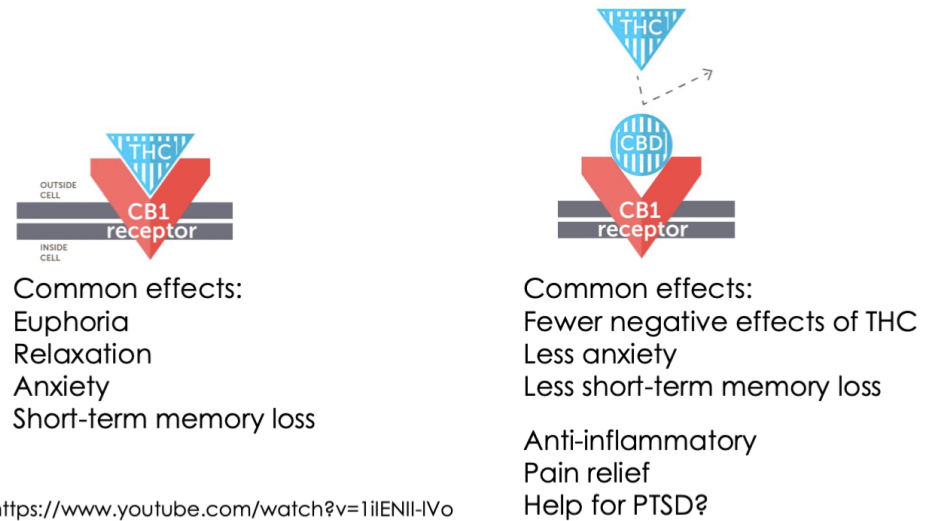
Recreational use
Herbal form: dried, matured flowers.
Resinous form: hashish (extract oil), lacks potency when you smoke it. Higher concentration of plant secondary compounds than the substance on the right.
Alters consciousness: happier, relaxed, munchies, different perceptions of music, color, space, time, different thinking, more paranoia, higher heart rate, thirsty, stoner face
smoke trip lasts 2-6 hours. Relaxation (CBD) vs. Euphoria (THC).
Negative effects on the brain: learning/memory deficiencies, attention deficit, psychosis, schizophrenia. Exacerbated in young brains (to mid 20s). Majorly reorganizes brain undergoing in adolescent brain as you move into adult brain.
3 in 10 cannabis users have CUD - cannabis use disorder. Mental addiction. Can’t stop, needing to use more each time, withdrawal symptoms.
Cannabis is a biochemical powerhouse! Scientists have demonstrated close to 500 different secondary compounds. Of those, close to 100 are cannabinoids . Of these, two are most interesting for human use: cannabidiol is not hallucinogenic and acts analgesic and anti-inflammatory, benefiting sufferers of chronic pain. There is also new and promising research into using the plant for sufferers of PTSD.
Cannabinol decreases the effect of THC, because it blocks the CB1 receptor.
Depressant drug plants
Poppy: first cultivation in Mesopotamia for anesthesia and rituals (10 000 y BP). Sumerian inscriptions called it the plant of joy.
Opium: latex released by cutting immature seed pods. 12% morphine, basis to produce heroin and codeine. Strongest painkiller around. Produces lots of alkaloids from opium sack. Harvested by extracting from immature seed pods as sticky sap.
Interpreted in history as an upside down poppy all around the world in historical art.
Poppy seeds are used in food with no significant effects because alkaloid levels are reduced when baked in comparison to fresh seeds. Once you bake it, not much happens. Kids bite them to get the effect.
Huge poppy business in Afghanistan: 90% of global production. 4 billion US $ and only a ¼ goes to farmers. 53% of country’s GDP. Cocaine in Colombia is only 2% of GDP.
China: 15-17th century increase in opium use recreationally, mixed with tobacco.
Europe: Laudanum = opium in alcohol (decrease pain increase sleep)
People get addicted. China wanted opium (India was a british colony) and Britain wanted silk, tea and ceramics. Bartering. With the opium addiction, China prohibited opium in 1729 and they burnt british opium shipment in 1839. 1839-1842 there was the 1st opium war. British victory - they got Hong Kong, and then China gree its own poppies and there was the 2nd opium war (1913).
Purified morphine: better dosage, basis of synthetic opioids.
Morphine is still the gold standard in palliative care
Strongly addictive
Morphine addiction in Soldier’s to cure PTSD - Soldier’s disease. Prohibits a good transition back home.
Heroin: touted as ‘non-addictive’ morphine substitute in cough medicine. by 1917 it was outlawed because it was 6x more addictive than morphine. Symptoms: euphoria, no pain, danger to overdose.
Stimulant drug plants
Tobacco
Very large leaves, collected, dried. Nightshade family - highly toxic, rich in alkaloids, do not eat
Stimulant: arousal in certain brain regions. Inhibition of heat, pain and hunger sensations. Increase adrenaline levels → heart rate and blood pressure increases. Pure nicotine used as an insecticide. Physically and psychologically addictive.
South American tribes chewed and smoked tobacco for millenia, domesticated there. Columbus brought it back to Europe in 1492. 1612 there were crop-plantations and enslavement for tobacco in Virginia. 1850s first cigarette. 1881 industrial manufacturing. 1960s peak use.
Why 10-15 million humans were abducted from their families in West Africa and put to slave labor on plantations.
Coca
3500 y BP. Lower feeling of hunger, thirst. Raised feelings of endurance. “Gift of the gods”. Leaves of a shrub, Colombia was the number 1 produce of the plant. Shows how it was consumed. Known as the gift of god.
Was used by spanish conquistadors and given to Indian slaves in silver mines. Increased productivity under harsh conditions. Still misused today.
1855: isolation from leaves. 1884: freud saw it as therapy. non-prescriptive drug for asthma, colds, hay fever. 1886: coca-cola. 1914: Harrison act, anti-narcotic law regulating Cocaine, morphine and heroin.
1960: resurfacing of cocaine in N America: one the worst drugs was created → crack cocaine.
Disruption of mood regulation and access of pleasure center. Overconfident high and a depressed come down. Side effects: heart attack, hemorrhage, respiratory failure, convulsions, psychosis, paranoia, insomnia, appetite loss. Physiological and psychological addiction, tolerance.
Cocaine and western abuse: US is the biggest consumer of cocaine. supe close is colombia. All other markets are secondary markets. Amount of cocaine production has gone up and people are trying and failing to police it.
The most important plant drugs in context
Ancient use - not recreational, used under supervision of shaman or elder. Spiritual and societal.
Top 4 today: Nicotine, cannabis, cocaine, opium (heroine, morphine, codeine).
Fentanyl is a synthetic opioid.
How much do people use and what fraction could kill you - Fentanyl and Heroin are the top. Marijuana and LSD is the lowest. Cocaine middle.
Canada: younger people. Fentanyl closing gaps of other opioids. Cannabis most legal drug worldwide besides cigarettes.
Future promising use of psychedelics
Things that are typically treatment-resistant like Depression, PTSD and addictions can be helped with psychedelics.
MDMA and ayahuasca (LCD) help with end-of-life anxiety in cancer patients.
Clean slate: neural pathways are loosened. Exposed to previously triggered interactions and can do new wiring. Opportunity to set down ne and innovative wiring patterns.
No long term studies about LSD and depression yet, but short term are significant. Psychedelics help Alcohol addiction and PTSD (research in progress)
LSD provides a good overall meaningful experience.
Plants that we thirst after
Plant oils and fats
Plant lipids
There are lots of different oils, with different tastes and properties. Nuts are typically the fattiest (Macadamia fattiest), then legumes and plants (lentils are very low).
Purpose of plant lipids: energy for developing embryo/seedlings, stored as mostly triglycerides in oleosomes. 1g of fat = 9 calories, where 1g of carb or protein = 4 calories
Triglycerides: fat molecule has fewer oxygen than sugar, allows it to be more dense.
Plant lipid characteristics: hydrophobic, non-volatile (no evaporation)
Fats: solid at room T, ±saturated
Oils: liquids at room T, ±unsaturated
Saturated vs unsaturated fats/oils
Glycerol skeleton has 3 fatty acids. It’s about how many carbon there are in the legs. Always 0 for saturation. 12 carbon connected to glycerol.
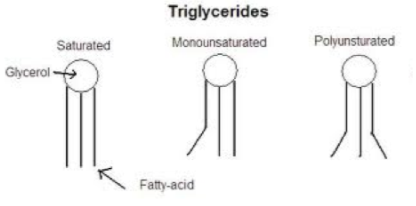
Oleic has one double bond, but in general fatty acids could have multiple where carbon chains are in the same plane, might be differ. Depends on which position the unsaturated bonds are at.
Cis vs. trans unsaturated fatty acids
cis - really hard to stack individual molecules in a spacing saving way. Putting them on top of each other. Trans are opposite plane.
Oils vs fats vs melting point
Animals - no double bonds between carbon, heat to get to liquid, higher BP
Plants - at least one double bond, can’t stack fat molecules on top of each other as easily.
May produce different types of fat based on the fraction of unsaturated vs saturated bonds. Simple saturation vs. double saturation.
The shorter the chain. the harder to store in space saving way which influences melting point. Trans fats are more likely to be solid at room temperature - fold in a space saving way.
Rancidification
Hydrolysis, oxidation of triglycerides → aldehydes, ketones, free fatty acids → bad smell, colour change. Chronic use of rancid oil is very unhealthy and can lead to diarrhea, organ damage, inflammation, carcinogenesis, and atherosclerosis.
You are at high rich of rancidification when you are polyunsaturated and based on cool or hot storage. Different plant oils: different ‘typical’ shelf lives. Different species have different shelf lives. Cool storage slows down plant life.
Hydrogenated fats
Not good for you. Turns something liquid into something harder. Soft fats into firm fats. Dry and stiff, like to turn liquid oils into firm fats. Start with unsaturated fat (liquid) and for through hydrogenation, complete chemical hydrogenation into single bonds. You get a mix if you push a cis unsaturated fat through the process. Turns a healthy fat into a mix. Increase melting point.
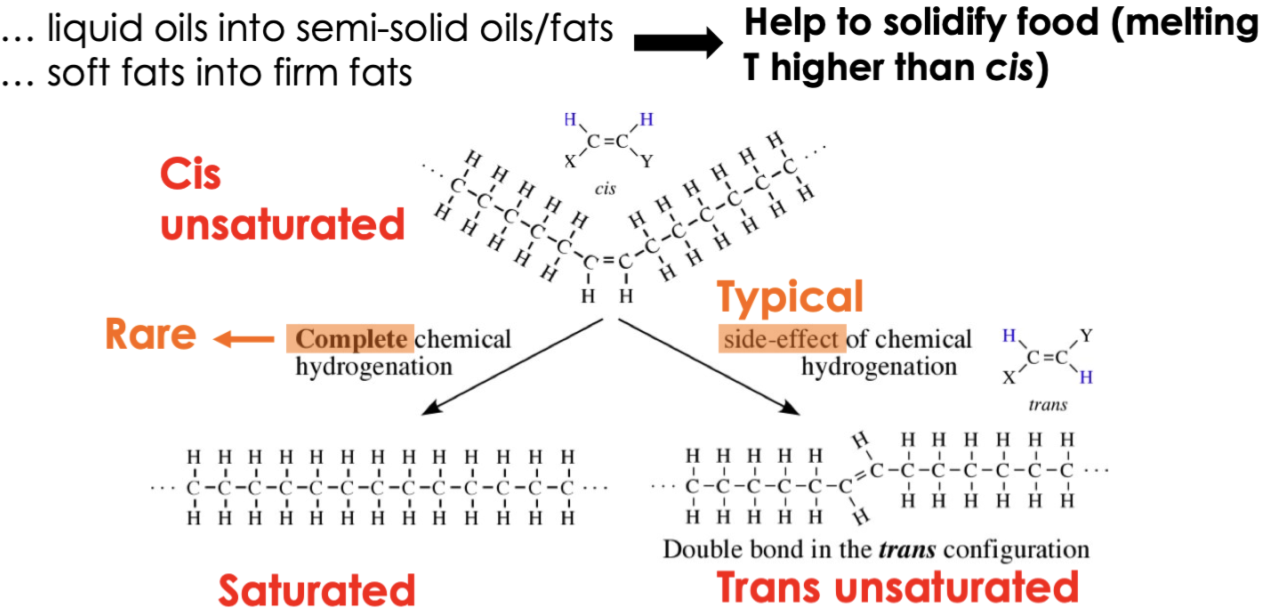
Lipids vs. human health
Saturated fats raise LDL and trans fats raise LDL and lower HDL (mostly from hydrogenation).
Hydrogenation controls regulatory risk of heat disease. We used to tell people to eat plant fat margarine over butter instead of animal fat, which is not entirely helpful. Margarine is partially hydrogenated and that’s bad.
Trans fat foods are bad.
Most mono-unsaturated fats are the healthiest. olive oil for dress and canola oil for stir fry (high smoke temp)
Olives
Cannot count annual growth rate of olive trees because they are hollow in the middle. There is a 2000-4000 y old olive tree in Greece though.
Olives have been in cultivation since 7000 y BP and they are produced through grafting (like with the grape trees), because growing olive trees from seeds is not great.
Theophrastus: olive must be propagated vegetatively, seeds give rise to thorny, wild-type olives.
16th century: Europeans brought olive to New World (Mexico, Peru, S America, later California).
Olives are ripe, collecting manually is not viable so you brush, hit, or mechanically get it down. Olives are collected with nets on the ground.
Oil extraction occurs at 27 degrees. Little droplets form to big droplets, squeeze mechanically, extract mix of oil and water → cold extraction.
Malaxation: most important step in oil extraction. Tiny oil droplets form larger droplets → easy separation from the aqueous phase.
Oil in olives is stored in vacuoles and in small scattered lipid inclusions in the cytosol: tiny droplets.
Malaxation activates natural enzymatic processes → slightly bitter olive oil taste (phenolics).
Later extraction steps: leftover paste after cold expression is steam-treated: remaining oil cells rupture → oil expelled under pressure. Even after hot expression, 10% of oil remains in plant.
Extraction by solvents is used for industrial use oil. Crushed olive pits, add hexane, recover organic phase. Oil recovery is about 95-99%
Cold extraction is better - crucial for oil quality. Decrease volatile aroma, polyphenols, and increases oxidation (decrease unsaturated fatty acids).
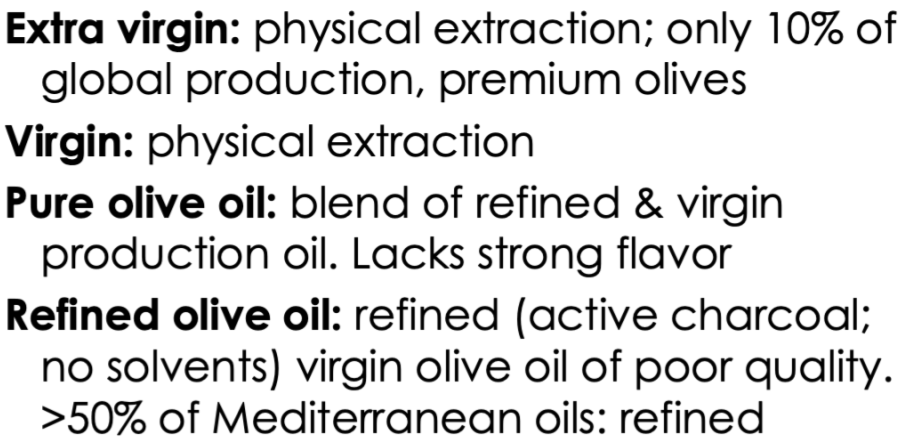
Canola
Rapeseed (Brassica napus) - comes from the brassica triangle. cross of turnip and cabbage. Very population Tribe (24 MYA)
Rapeseed oil: used in industry as a lubricant. In WW2 can exported to Europe to increase production, and after it was used for cooking and animal feed (excess).
Was still 40-50% erucic acid, with an unpleasant taste. Plant fodder: glucosinolates → toxic effects in both humans and animals at high doses.
CANadian Oil, Low Acid - CANOLA
got down to 2% erucic acid, lower levels of toxic glucosinolates in leaves so it became good livestock feed.
Canada was the biggest exporter.
80% of canola grown in Canada is genetically modified - herbicide tolerant and drought tolerant.
Alcohol
Alcohol fermentation occurs through the use of yeast. Glucose or fructose or sucrose → add yeast → yield cellular energy and ethanol CO2.
The jump between 10 to 22 percent is based on length it is in a barrel for. Water evaporates and the alcohol concentration raises. If beer was above 14% it would kill the yeast and become toxic. Distillation is how you get higher alcohol content in beer.
Since as long as we’ve been using alcohol we’ve been abusing it. LD50 is how many shots could kill you.
80 - 8 , 100lb -10, etc.
Alcohol harms: liver cirrhosis, DUI, household debt, domestic abuse, fetal alcohol syndrome
Alcohol is intermediate drug type. Level of physical harm is lower than dependance. Some papers list it as number one harm to others (friends and family suffer).
Prohibition
Outgoing 19th century - rampant alcohol problems in the US and Canada
Women pushed for alcohol temperance laws and the liquor raids in Ontario - alcohol was dumped into fields.
Temperance movement: lasted the longest in PEI (1901-1948), and in general was 1918-1920. Cree nation has been dry since 2017.
US wide prohibition lasted 1920-1933.
Canada very quickly recognized prohibition as a failure. Drunkenness grew under prohibition. Increased consumption of bad liquor most notably.
Money ended up in the pockets of organized crime
People drank more hard liquor → if i cheat, cheat hear
Moonshine: low quality black market produce. Carbohydrates produced methanol and there was mass poisoning, permanent health damage (blindness, brain damage, and death).
War on drugs, Zero tolerance, just say no - a bunch of non-viable options and solutions
LCBO: ON historically very strict. Designed to make it difficult to get alcohol, to quell anxiety. If you wanted to buy liquor, you needed a license and need to renew it every year.
Management of demand: very difficult. Marginalized minorities are highest at abusing alcohol, which is why the cree nation elder’s made the nation dry in 2017.
Canada and Cannabis legalization → missing state tax revenues, underground supply, biased criminalization of users, increased use, overstretched law enforcement, dirty uncontrolled drugs.
Opioids are not the same cuz they’re way more addictive
Societal setting of drinking
Wet cultures: high per capita consumption, permissive culture
Dry cultures: low per capita consumption, strong sanction
Blended: in between, we are blended in Ontario.
Most of the world is 18-19 year old drinking age, many have light or no laws, and many are illegal. Lithuania has the highest per capita pure alcohol consumption - 18.2 alcohol consumption (liters) per year. Canadians drink 10.0 L of alcohol a year.
Norway (blended culture) vs. Czechia, France and Switzerland as wet cultures.
Wet culture have consumption higher in older ages, while blended is pretty consistent.
Guys drink more than women. Czech highest ratio. Mid ratios.
Blended cultures have highest rate of binge drinking
Blended cultures have highest alcohol related injuries, blackouts and loss of drinking control.
Minimize abuse: making alcohol a natural part of life. Teach young by example of moderation. Drink with family/friends. Discourage heavy, episodic drinking. Perspectives opportunity.
Beer
Sumerian Mesopotamia (Iran; 6000 Y old): residue on a piece of pottery. Shows people drinking beer with a straw. Oldest alcoholic beverage. Iran now a dry country. Grains still in the vat.
Egyptian staple: healthy and nourishing, given 3x a day to workers at pyramids, also as wages.
Romans brought beer brewing to France and Britain. First use of hops was in French monasteries.
Europe in the middle ages used beer for nourishment - for pilgrims from infants to the aged. Inhabitants and visiting migrants.
Weihenstephan brewery: near munich in Bavaria in Germany (1040 AD). Oldest beer brand in the world.
Beer brewing
Only ingredients known in 1487 - barley, hops, water (yeast wasn’t known yet)
Law: since been repealed, but many breweries still follow the above “allowed ingredients” for marketing.
Base ingredient: sugars, soluble starch, and starch to sugar enzyme necessary for fermentation. Barley provides starch, why it is such a popular plant.
Hops: dried female blossoms of a dioecious vine. Adds bitter flavour and helps preserve beer. Most sought after in Germany and Czechia. Dry and harvest all together in a big field of them. Glands have the good shit.
Any water good enough to drink is good enough to brew with - they would brew on Wednesdays so you couldn’t pee in the lake on Tuesdays.
Yeast: single-celled fungus - sugar → ATP, CO2, alcohol. Two main varieties (ale yeast and lager yeast), hundred of strains. Each strain produces a differently flavoured beer.
Monasteries: brewed and baked in the same place because the CO2 from bread ferments the beer. Airborne yeast spores.
Malting: different temperature different colours of malt (beer)
Steeping → 40h, bring back to life
Germination → 5 days, activate plant enzymes to start breakdown of long-chain to simple sugar
Kilning: kill seedling (keep enzyme functional)
Milling: whole seeds to grists → larger surface area
Mashing: add water to dissolve carbs. Strain out ‘spent’ barley. Heat liquid to deactivate enzymes.
Brewing: addition of hops at different times. Many complex volatile compounds for aromatic flavouring.
Whirlpool: removal of spent hops
Pitching of yeast: cool liquid to ideal temp to help yeast survive. Fermentation of up to 10 days.
top fermentation: Ales (yeast on top), room temp.
Bottom fermentation: lagers (yeast on btm), 4 degrees.
Carbonation in bottles: Small amount of sugar added to brew → final fermentation cycle. CO2 trapped. Further maturation in bottles. Pasteurization in beer bottle (kills yeast, stops fermentation)
The first step in beer brewing is steeping where barley is soaked in water to start its metabolism. After this steeping period of 40 hours, the seeds germinate for five days. The reason for this is to allow the naturally occurring enzymes in barley seeds to break down long-chained carbohydrates into short-chained ones . In order to stop the process of germination , the seeds are kilned which results in their death . The steeping, germination and kilning is referred to as malting .
Plant that provide warmth and strength
Nature and growth of plant fibers
Fiber: sclerenchyma. Long, narrow, tapering cell. Dead at maturity. Cell interior almost completely filled with cell wall material. Function: structural strength. Cell walls thickened with cellulose and usually enforced lignin.
Parenchyma is the primary cell wall and is alive. The cell wall, cell membrane and pit (plasmodesma) are all involved. Sclerenchyma is dead at maturity, with the primary and secondary cell wall continued growing.
Primary cell wall: synthesized during initial cell growth. Elastic and plastic → withstands cell pressure, but enables cell extension/growth. Cell wall components → cellulose microfibrils interlocked by hemicellulose, pectins, and structural proteins. Closest to middle lamella.
Cellulose cynthase complex is embedded in the plasma membrane
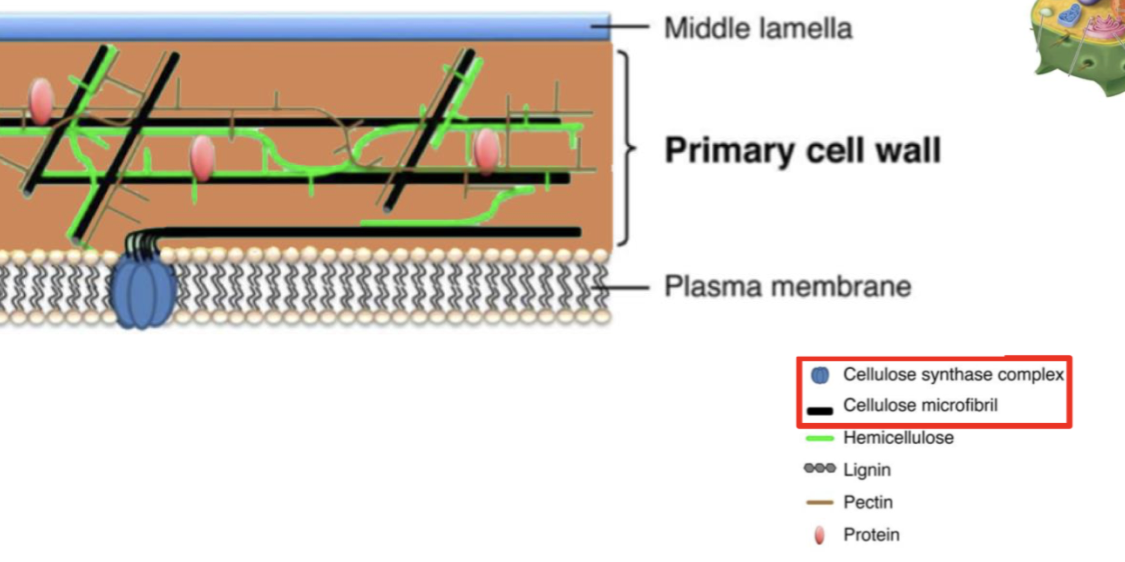
Cellulose fibers → microfibrils makeup macrofibril make up cellulose fibers.
6 B-glucan chains → 1 rosette subunit, 6 rosette subunit → 1 cellulose microfibril, 36 B glucan chain in one cellulose microfibril.
Primary cell wall is the beginning of growth of the secondary cell wall. Adjacent to cell wall has reproduced secondary cell wall. Plasmodesmata: tiny holes that aren’t covered by secondary cell wall so we can see primary. Cell wall grows towards centre, multiple layers of secondary cell because it dies at maturity once completely full. Stuff in cell wall, located away from plasma membrane, continues to produce microfibrils.
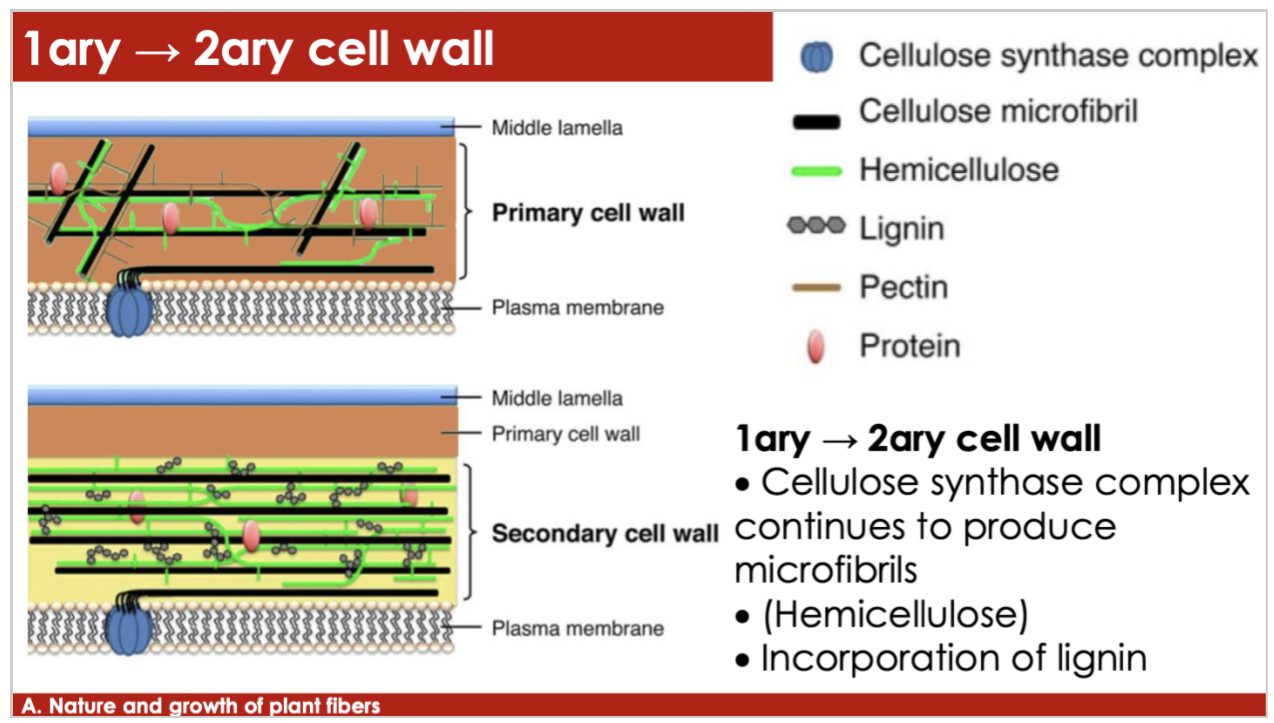
Primary cell wall: in all plants. Elastic, thinner. No lignin, and low cellulose
Secondary cell wall: only in some mature and non-dividing cells. Rigid, thicker. Lots of lignin, strong hydrophobic, antimicrobial. High in cellulose. Most of what fiber consists of.
Cotton
Cotton: top fiber plant in the world. Seeds are a source of cooking oil, and the residue after extraction can be animal feed.
Surface fibers: anchored on the surface of seeds. Fruited bottom, mature infructescence. Still see some fibers connected to seeds, but otherwise you see those majority cottons. Wind dispersed, many hairs allow it to be carried by the wind.
Paper money is 75% cotton, 25% linen.
Approximately 14 500 fibers per seed. Each fiber is one cell. Less than 2.5 cm long. Fibers grow from seed epidermis. Almost 100% cellulose. Among largest plant cells.
1ary growth → fiber length (elongation, twisting, bundling), 2ndry growth → strength and physical properties (dry weight added)
Important for nature of cotton to have all these convolutions
Many 2ary cell wall layers (cellulose) → deep absorption of dye and water (25x own weight), pleasant feel.
Convolutions: uneven fiber surface. Increased inter-fiber friction, increase ease to spin yarn.
Domestication history
There were 4 different species of cotton domesticated. All species have different characteristics - fiber length, strength. Asia, Africa → diploid cotton.
The two frem the New World are both tetraploidy: Gossypium hirsutum from Mexico provides max yield. Gossypium barbadense from S America has the longest fibers. Occurred through heterosis or hybrid vigor.
Human impact of cotton
1794 Whitney patented the cotton gin → easy separation, cotton became major export from tropics, expansion of cotton producing areas, enslaved people used to pick mainly cotton balls. Key element of industrial revolution. There were too many fields which is why they used slaves.
Great Britain was desperate for cotton. Cotton spinning in Manchester was the heart of it all.
1835: Emancipation of British slaves, British cotton production collapsed.
1850: 80% of cotton supplied to English cotton mills was from SE US → huge expansion of slave-drive cotton agriculture. Biggest plantation owners became rich and got away with their large slave encampments.
1861: start of civil war → 4 million enslaved people in the US
1865: South lost, slavery was abolished. Reconstruction era.
Sharecropping: former enslaved families rent small plots from landowner for a portion of their crop at the end of the year. The cycle of poverty. Inflation of what sharecroppers owed them for housing. Enslaved treatment was worse than before.
Late 19th century - 1965: Jim Crow Laws - “separate but equal”
In practice, Jim Crow laws mandated racial segregation in all public facilities in the states of the former Confederate States of America and in some others, beginning in the 1870s. Public education had essentially been segregated since its establishment in most of the South after the Civil War. The legal principle of separate but equal racial segregation was extended to public facilities and transportation, including regional and state coaches of interstate trains and buses. Facilities for African Americans were consistently inferior and underfunded compared to facilities for white Americans. As a body of law, Jim Crow institutionalized economic, educational, and social disadvantages for African Americans living in the South
Early-mid 20th century: Violence against black lives, public lynching, burning down whole neighbourhoods, white supremacist groups
1910 - 1970: Great American Migration. Out of the south into other regions of N America. Wasn’t organized, just many families had had enough. Hoped for better jobs, equality, and safety, but ended up with low-wage factory work, socially financially and educationally segregated neighbourhoods (not by law)
First was North, second was North and West. Mostly California and Washington the second time.
The Great Migration, sometimes known as the Great Northward Migration or the Black Migration, was the movement of 6 million African Americans out of the rural Southern United States to the urban Northeast, Midwest and West that occurred between 1916 and 1970. It was caused primarily by the poor economic conditions as well as the prevalent racial segregation and discrimination in the Southern states where Jim Crow laws were upheld .
1948: Start of desegregation in the south
1950: Mechanization of cotton harvest
2020: BLM
Still and existing effect of plant-driven colonialism and white supremacy.
Environmental impact of cotton
1960s: Soviet plan for cotton to become major export. Diversion of large fractions of Amu Daria and Syr Daria rivers. Flowing into Aral sea. Today Uzbekistan (Desert) is one of the world’s largest cotton exporters.
In Central Asia. Turn very arid and dry land into major production point for cotton, as an export article. It needs lots of water, and the area is a desert so they planned to move water into field.
Aral sea’s fish production went down, the entire things shrunk, water is not basically completely dried up. One of the worst human disasters. Transboundary water mismanagement, and 3.5 million people affected.
Saline groundwater now limited access to healthy drinking water. Salt washed from fields are wash into the lake (also pesticides). Dust is highly toxic as well, and is one of the worst areas to live, but it is controlled by Russia so we don’t hear much. Decreased human fertility, increased infant mortality, various disease, increased cancer rate, life expectancy 51 years.
Cotton picking still exists as a form of modern slavery in places, and is on the radar of human rights watch.
Flax
Source of linen. Most useful → source of fibers, seeds and oil. The oil is very healthy as well.
Domestication occurred in fertile crescent. Healthy omega-3-fatty acid. Canada is the number 1 flax producer.
Fiber bundle occurs in a sea of cells.
By the end of the stages of fiber thickening, the cell is dead. Fibers make spindly flax stems strong. Strong than stems of most equally thin plants → allows flax to grow tall.
Dyed flax fibers found in cave in the Caucus dating back to 36 000 y BP. People were harvesting flax and turning it into clothing, no cutting. Plant harvested by ripping it out of the ground for the longest possible fibers.
Internal flax fibers: less accessible than surface fibers.
Before they needed to be rippled (pulled through while seed capsules make it past stem)
Scutching: fibers finally separated from useless chaff
Heckled: another comb, fibers are stretched. Put through spinner, woven into fabric. Similar to cotton, it can absorb water and has a good feel on the skin.
Retting: This is the activity to allow microorganisms (under the influence of moisture) to decompose the epidermis of the plant stem and part of the bark, in order to expose fiber bundles
Rippling: This activity serves to rip off the seed pods from the stems, containing the nutritious seeds
Breaking: The plant stems are fractured in order to separate fiber cells from parenchyma and other useless issue
Scutching: In this activity, the broken stems are repeatedly hit with a stick so that the fibers separate from parenchyma and other useless tissue
Heckling: This is another term for combing the fibers and separate short (not very useful) from long fibers
Paper making
Short history
105 AD: first paper out of individual fibers (they ditched old mulberry bark, hemp, old clothing, fish nets to turn it into paper). China kept the secret for over 600 years.
750 AD: first paper made outside of China (all paper is manually produced)
1450: Gutenberg printing press
1487: almost every European country prints large quantities of books → increased need for paper, but there was issues with limited fiber
1495: first paper mill in england (hemp, cotton, linen)
1600-1700: renaissance → increasing literacy, surging demand for paper
1666: British law forbid burial of dead in cotton and linen.
Paper production (old)
Thin layer of study fibers, separated and used for papers. Water retting shows old situation. Extracting the fibers. Water retting. Fiber-rich plants were used (mulberry, hemp, bamboo)
Boil loosened fibers (from short cell) in water → create slurry of fibers
Scroop up slurry onto wire screen in wooden frame, let settle
Drained fiber layer put on felts; press felt layers
Hang sheets to dry
Paper production (new)
Source: wood fibers. Not as good quality. Specifically the xylem. Mulberry used the true internal fibers. Water conductive tissue.
Xylem: longer and strong than parenchyma cells
Two main type of tissues are used: tracheids in gymnosperms, and modern trees have smaller vessel members. Paper is made out of true fibers. We need so much damn wood.
Cellulose: most desirable wood component. Common in cell walls of tracheids and vessel elements. 23-32% heavy cellulose.
Hemicellulose: is intermediate wood component
Lignin: obstacle of wood components and fibers. Amorphous, non-reactive ‘glue’.
Pulping: separation of cellulose from lignin. Mechanical abrasion (wet wood) ground by large stones), chemical pulping (chemicals dissolve lignin). Produces slurry.
Mechanical - 90% with low quality and impurities, suitable for packaging paper
Chemical - 50% high quality long tracheids/vessels, puple treated with acid or alkaline to break down lignin
Recycled paper - low grade paper, decreased durability, strength, colour
Refining pulp: xylem = hollow, smooth tubes → bad surface contact, low bonding, soft and flimsy. Collapse xylem and shred surface. Smush and smear them. Xylem flex and release - collapse. Chemical bleaching will make white paper.
Fourdrinier paper machine
Feed slurry into headbox. Suspends so they don’t form fiber tangles.
Deposition of fibers on table. Suction drainage of water through mesh wire. Keep slurry agitated to insure random distribution of fibers.
Wet press section. Rollers squeeze water from pulp.
Dryer section. Heated dryer drums progressively dry pulp, as it turns to paper. May include electric or gas infrared heaters. Run through hot wheels.
once water evaporates, you get direct connection with cellulose components
Calendar section. Metal rollers compress paper to form uniform thickness. May be smoothened to include some sort of pattern or texture. Paper gets banged and squished.
A typical printing paper is 7-8 fibers thick
Ecological impact of paper
All steps contribute to global warming. They need so much energy and there is a huge decomposition creates methane - greenhouse gas is stronger than carbon monoxide.
Harvesting trees still goes on. Not what it was before.
Paper industry is the 3rd largest emitter of greenhouse gases. 50% production of pulp 50% running fourdrinier machine (on oil). Requires a ton of water. 99.5% water taken in, and because acidity is used, water is wasted and need to go somewhere → quality of downstream water is so much worse off than the upstream water.
Dioxins, polluted water. Sulfur, hydrogen sulfide, and sulfur dioxide from chemical pulping creates acid rain.
Paper recycling → fiber degradation with each step, cannot be used again and again. High quality printing paper needs new fibers. Recycled is just cardboard.
With or without recycling paper decomposition in landfills produce methane at 23x more potency than GHG than CO2. Paper 1/3 of municipal solid waste. Municipal landfills have 1/3 of human related methane emissions to atmosphere.